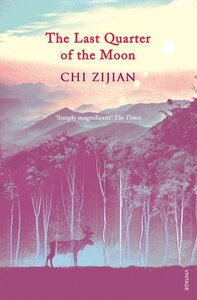I’ve had this book (originally published in Chinese in 2005) on my shelves for a few years, and finally took the time to read it. I’m glad I did.
The Last Quarter of the Moon is set among the Evenki people, reindeer herders of north-eastern China. The narrator is a ninety-year-old woman, who doesn’t reveal her name because she doesn’t want traces of herself to be left behind. Most of her clan are moving permanently to the town, leaving their nomadic lives behind. She remains, telling her story to “the fire and the rain”.
When the narrator is growing up, it’s clear how much her people’s lifestyle is shaped by the landscape:
But we were unable to leave this river. We always treated it as our centre, living alongside its many tributaries. If the Argun is the palm of a hand, then its tributaries are five open fingers. They extend in different directions, illuminating our lives like flashes of lightning.
Translation by Bruce Humes
There are vivid descriptions of place throughout Chi’s novel. As a whole, the book is structured around changes in the narrator’s family, set against the broader movement of history and encounters with outside cultures. Throughout, there is the sense of just how precarious is the Evenkis’ traditional culture. The story always comes back to the personal, but Chi makes clear how much is really at stake.
Published by Vintage Books.


Recent Comments